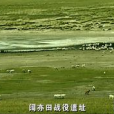阿拉善高原亞區海拔90—2500米。
基本介紹
- 中文名:阿拉善高原亞區
- 面積:40000 km
- 著名景點:流沙
- 海拔:90—2500米
基本介紹,英譯,
基本介紹
北為國界,東為地區界,西面直抵黑河西岸的馬鬃山地東端,南面則以龍首—合黎山鄰接河西走廊,界線比較不明顯,因為龍首—合黎山向西延長的夾山以及向東延長的紅崖山等,均低矮而狹窄,當地民眾常把山地以北的一些阿拉善地台邊緣拗陷盆地——花海子——金塔盆地、潮水—民勤盆地等,包括在河西走廊範圍之內.
阿拉善高原在地質上是一個長期穩定的剝蝕地塊,燕山運動時期在南部邊緣形成了一些斷裂山地與拗陷盆地.東北—西南向或東西向的乾燥剝蝕山海拔90—2500米.乾燥剝蝕山地之間則為一系列淺寬的盆地,也即高原面所在。
土地類型以剝蝕石質戈壁和洪積礫石戈壁為主,盆地中心還有一些沙礫戈壁與鹽沼,其中吉蘭泰鹽池和雅布賴鹽池是重要池鹽產地.在阿拉善高原邊緣的較大山間盆地,則是廣大沙漠,
主要有三塊:
(1)巴丹吉林沙漠分布於西南邊緣,面積約4萬平方公里,其中流沙約占83%,是中國第二大流沙,高大的複合型沙山密集,高20—300米,最高達420米,是全世界最高大的沙丘;沙山之間,又有144個水色深碧的內陸湖泊,周圍水草比較豐美,是當地放牧中心.
(2)騰格里沙漠位於東南邊緣,面積約3萬平方公里,主要自然特點是流動沙丘與水草較豐美的湖盆交錯分布,大小湖盆達422個,多數已乾涸.
(3)烏蘭布和沙漠位於東北邊緣,面積約14萬平方公里,四周為剝蝕山地B荒漠,山麓為礫石戈壁,廣大盆地中心為沙漠(流沙、半固定、固定各約占13),北部地區和黃河沿岸還有大片土質平C地.石羊河和黑河下游有廣闊的沖積、湖積平原.石羊河下游的白亭海(淡水),已乾涸變為鹽沼;四周為騰格里沙漠及廣大戈壁灘所包圍,中間則是民勤綠洲.黑河下游介於巴丹吉林沙漠和馬鬃山地之間,僅在洪水季節有水,最後瀦為嘎順諾爾(居延海)及索果諾爾.前者湖面海拔820米,
原為鹽湖,現已乾涸.後者湖面海拔879米,湖水可向嘎順諾爾排泄,又有河水補給,因而礦化度僅3—5克升,但在1959C年後,水質劇烈惡化
英譯
.Borders the north east of the region, on the west reaching as far east end of Black River in the WestBankMazongshan to the south Zeyi Longshoushan - heli mountain adjacent to the Hexi Corridor, the line lessobvious, because the first dragon - Hop Li Shan westward extension of theSandwichHill, as well as the east extension of hongyashan, are low and narrow, the local people often put some of the mountainous north of the platform edge Alashan sag basin - huahaizi - Jinta Basin, tides - Minqin Basin, etc. included in the Hexi Corridor range. Alxa Plateau is a geologically long-term stability of the denuded land, during the Yanshan movement in the southern edge of the formation of a number of broken mountains and sag basin. northeast - southwest or east-west to the dry erosion Mountain 90-2500 m above sea level. dry and denuded mountains, compared with a range between the wide shallow basin, that is where the plateau surface. the types of land to erosion and alluvial gravel Gobi desert stone mainly basin center and some gravel Gobi and salt marsh, which JILANTAI Yanchi and yabrai Yanchi is an important lake saltorigin. Alxa Plateau in the edge of the larger mountain basin, it isvastdesert, mainly three: (1) located in the southwest edge of Badain Jaran Desert an area of about 4 million square kilometers, of which about 83% of the quicksand, isChina's second largest sand, tall sand hills, dense composite, high-20-300 meters up to 420 meters, is the world's tallest sand dunes; sand between mountains, another 144 water color depth Bi's inland lakes, surrounded by relatively lush plants, is the local grazing Center. (2) the southeast edge of Tengger Desert is located in an area of about 3 million square kilometers, the main natural features of the mobile dunes and of the lake basin than the lush plants staggered distribution, the size of the lake up to 422, most have dried up. (3) Ulan Buh Desert in the north-east edge of an area of about 14 million square kilometers, surrounded by B for the denudation of mountain desert, the foothills of the Gobi gravel , the majority of the Center for Desert basin (sand, semi-fixed, fixed all about 13), the northern region along theYellowRiver, and there are large areas ofsoillevel C to. Shiyang and the Heihe River has a vast alluvial and lacustrine plains. Shiyang downstream The Baiting sea (freshwater), have been dried into salt marsh; four weeks for the vast Gobi Desert, Tengger Desert and surrounded by the middle is the Minqin oasis. Heihe River between Badain Jaran desert and Mazongshan manner, with only of water during the flood season, the final retention of gaxun nur (Juyan sea) and Sok fruit Knoll. The former lake elevation of 820 meters, formerly Salt Lake, have been dried up. The latter lake elevation of 879 meters, the lake can gaxun nur excretion , another water supply, and thus salinity is only 3-5 grams of l, but the 1959C years later, adramaticdeterioration of water quality.

